Mario Andretti facts for kids
Quick facts for kids
Mario Andretti
|
|||||||
|---|---|---|---|---|---|---|---|
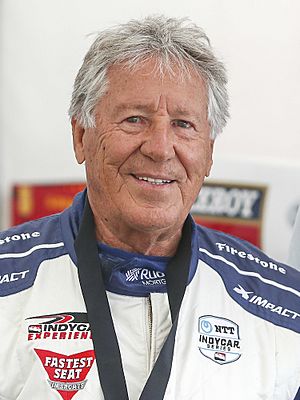
Andretti in 2021
|
|||||||
| Born |
Mario Gabriele Andretti
February 28, 1940 Montona, Istria, Kingdom of Italy
|
||||||
| Spouse(s) |
Dee Ann Hoch
(m. 1961; died 2018) |
||||||
| Children | 3, including Michael and Jeff | ||||||
| Relatives |
|
||||||
| Championship titles | |||||||
|
|||||||
| Formula One World Championship career | |||||||
| Nationality | |||||||
| Active years | 1968–1972, 1974–1982 | ||||||
| Teams | Lotus, privateer March, Ferrari, Parnelli, Alfa Romeo, Williams | ||||||
| Entries | 131 (128 starts) | ||||||
| Championships | 1 (1978) | ||||||
| Wins | 12 | ||||||
| Podiums | 19 | ||||||
| Career points | 180 | ||||||
| Pole positions | 18 | ||||||
| Fastest laps | 10 | ||||||
| First entry | 1968 United States Grand Prix | ||||||
| First win | 1971 South African Grand Prix | ||||||
| Last win | 1978 Dutch Grand Prix | ||||||
| Last entry | 1982 Caesars Palace Grand Prix | ||||||
| Champ Car career | |||||||
| 407 races run over 31 years | |||||||
| Best finish | 1st (1965, 1966, 1969, 1984) | ||||||
| First race | 1964 Trenton 100 (Trenton) | ||||||
| Last race | 1994 Monterey Grand Prix (Laguna Seca) | ||||||
| First win | 1965 Hoosier Grand Prix (IRP) | ||||||
| Last win | 1993 Valvoline 200 (Phoenix) | ||||||
|
|||||||
| NASCAR Cup Series career | |||||||
| 14 races run over 4 years | |||||||
| First race | 1966 Motor Trend 500 (Riverside) | ||||||
| Last race | 1969 Motor Trend 500 (Riverside) | ||||||
| First win | 1967 Daytona 500 (Daytona) | ||||||
|
|||||||
| 24 Hours of Le Mans career | |||||||
| Years | 1966–1967, 1982–1983, 1988, 1995–1997, 2000 | ||||||
| Teams | Ford, Mirage, Porsche, Courage, Panoz | ||||||
| Best finish | 2nd (1995) | ||||||
| Class wins | 1 (1995) | ||||||
Mario Gabriele Andretti (born February 28, 1940) is a famous American former racing driver and businessman. He competed in many different types of racing. These included Formula One from 1968 to 1982 and IndyCar from 1964 to 1994.
Andretti won the Formula One World Drivers' Championship in 1978 with the Lotus team. He also won 12 Formula One races over 14 seasons. In American open-wheel racing, he won four IndyCar National Championship titles. He also won the famous Indianapolis 500 race in 1969. In stock car racing, he won the Daytona 500 in 1967. Mario Andretti is also a three-time winner of the 12 Hours of Sebring in endurance racing.
Mario was born in Italy. His family had to leave their home in Istria in 1948. They moved to Nazareth, Pennsylvania in the United States in 1955. He started dirt track racing with his twin brother Aldo when he was 19. Mario quickly became a top driver. He is known for his amazing skill and for winning races in many different kinds of cars.
Contents
Mario Andretti's Early Life
Growing Up in Italy
Mario Gabriele Andretti was born on February 28, 1940. He was born in Montona, Istria, which was part of the Kingdom of Italy at the time. Today, this place is called Motovun, Croatia. Mario was born just six hours after his twin brother, Aldo. Their father, Alvise "Gigi" Andretti, worked on a farm in Italy. Their mother was Rina. Mario also had an older sister named Anna Maria.
The Andretti family owned a large farm. But after World War II, their land became part of Yugoslavia. Because of this, the Andretti family had to leave their home in 1948. They lost all their land and could only take one truckload of their belongings. They lived for seven years in a refugee camp in Lucca, Italy. It was an old college building with no running water.
Mario and Aldo loved racing from a young age. When they were five, they raced wooden cars they made themselves through the streets of Montona. After moving to Lucca, they got a job parking cars at a local garage. Mario wrote in his book that he was "hooked" the first time he started a car. He said he still gets that feeling every time he gets into a race car.
The garage owners saw how much the brothers loved racing. They took them to watch the 1954 Mille Miglia race. This race was won by Alberto Ascari, a two-time Formula One champion. Ascari became Mario's hero. The twins also visited Monza to see the Italian Grand Prix. Mario saw Ascari race against another legend, Juan Manuel Fangio. Mario remembered being "mesmerized" by the sound and speed of the cars.
Moving to the United States
The Andretti family waited three years for their visas to the U.S. They finally moved to the United States in 1955. After an eleven-day trip on a ship, they arrived in New York Harbor. They had only $125 and settled in Nazareth, Pennsylvania. Mario's uncle, Tony, lived there. Mario's father planned to stay for five years, but the family never left the U.S.
Mario did not want to leave Italy at first. His father believed that moving to America would give his children the best chance to succeed. However, his father did not want his sons to become race car drivers. Racing was very dangerous back then. Mario had planned to become a welder. But racing was his "only passion." He felt he might not have become a racer if he had stayed in Italy. Mario's father did not watch him race until Mario reached IndyCar in 1964.
Mario became a U.S. citizen on April 7, 1965.
Mario's Early Racing Career
Starting in Dirt Track Racing
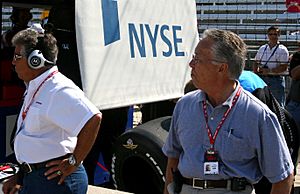
Mario's first car was his father's 1957 Chevrolet. The twins didn't race it, but they made it better. They were surprised to find a half-mile dirt track in Nazareth, called Nazareth Speedway. They used money from working at their uncle's gas station to fix up an old 1948 Hudson. They even used a stolen beer barrel as a fuel tank!
The car was ready when they were 19. But the racing age limit was 21. So, the brothers convinced a newspaper editor to change their driver's licenses. After Aldo had a big accident, the police chief saw the fake license. But he looked the other way to help Aldo's health insurance.
The twins did not tell their father they were racing until Aldo broke his skull in a race. Aldo was in a coma for 62 days. Mario's father almost disowned Mario when he insisted on racing again. But he eventually agreed. Aldo also raced again, but a serious accident in 1969 ended his career.
The twins started well, winning two races each in their first four sportsman races. In their first two weeks, they won $300. Before that, they made $45 a week at the gas station. From 1960 to 1961, Mario won 21 out of 46 modified stock car races. The twins raced against each other only once in 1967. Mario won, and Aldo finished 10th.
To scare their rivals, the twins bought Italian racing suits. They made up a story about racing in Italy. Mario kept this story going for many years. In 2016, he admitted it was fake. He said it "psyched [the opponents] out, big time."
Racing Single-Seater Cars
Mario wanted to race in open-wheel cars. He started with midget cars from 1961 to 1963. He won a midget race in March 1962, calling it his "first victory of any consequence." In 1963, he raced over 100 times. He finished in the top five 29 times in 46 races. He ended the 1963 season in third place.
The next step was sprint car racing. Mario got a full-time ride with USAC team owner Rufus Gray for 1964. He won one race and finished third in the season standings. To pay for his racing, he worked as a foreman at a golf cart factory.
Mario continued sprint car racing after moving to IndyCar. In 1966, he won five times. In 1967, he won two of the three events he entered.
Mario's IndyCar Career
From 1956 to 1978, the top open-wheel racing series in North America was the USAC National Championship. It was also called IndyCar or Champ Car.
Breaking into IndyCar (1964)
Mario started in IndyCar during the 1964 season. He was still racing sprint cars full-time. On April 19, 1964, he raced at the 1964 Trenton 100. He started 16th and finished 11th.
Mario looked for a full-time IndyCar spot in 1964. A chance came up when a top team, Dean Van Lines Racing Division (DVL), needed a driver. Mario met with the team's chief mechanic, Clint Brawner. Brawner was unsure about Mario at first. But Mario impressed him in two races. Brawner saw that Mario worked hard on the car, like another young star, A. J. Foyt. Mario joined DVL and finished 11th in the season standings. He was named IndyCar Rookie of the Year. Brawner then made Mario his permanent driver.
Dominating with DVL and STP (1965–1969)
The team of Andretti and Brawner soon became very successful. They got support from Firestone and Ford. From 1965 to 1969, Mario won three USAC IndyCar titles. He won 29 of 85 USAC races between 1966 and 1969.
In 1965, Mario's first full season with DVL, he used a new car called the Brawner Hawk. He finished third at the 1965 Indianapolis 500. This earned him the Rookie of the Year award for that race. He won his first IndyCar race at the Hoosier Grand Prix. He won only one race that year, but he finished second six times and third three times. He scored points in 16 of 18 races. At 25, Mario became the youngest IndyCar champion ever. This record lasted for 30 years.
In 1966, Mario won his second straight USAC title. He won eight of fifteen races and led 1,142 laps. This was nearly 1,000 more laps than his closest rival. He led 54.5% of all laps in 1966, a record until 1970. Mario also got the pole position at the 1966 Indianapolis 500. But he had to stop after 27 laps due to a mechanical problem.
In 1967, Mario lost the USAC championship to A. J. Foyt. Mario won eight races, but Foyt won the 1967 Indianapolis 500. Mario was on pole at Indianapolis but lost a wheel. Mario raced with broken ribs to stay in the title race. Foyt had a big lead going into the last race. Mario ran out of fuel with four laps left. He finished third, losing points. Foyt's tire sponsor helped him take over another car to prevent Mario from winning. Foyt finished fifth and won the championship. Mario received his first Driver of the Year award. But he was sad about how the season ended.
The owner of DVL, Al Dean, passed away in 1967. Mario bought the team's cars and staff. He became an owner-driver under the name Andretti Racing Enterprises. Brawner stayed as chief mechanic. In 1968, Mario again lost the title in the last race. His engine failed, and he had to borrow other cars. He finished third but got fewer points. Bobby Unser won the title by a very small margin. Despite losing, Mario set records for second-place finishes (11) and podium finishes (16) in a season.
| # | Season | Date | Sanction | Track / Race | No. | Winning Driver | Chassis | Engine | Tire | Grid | Laps Led |
|---|---|---|---|---|---|---|---|---|---|---|---|
| 1 | 1968 | August 4 | USAC | Circuit Mont-Tremblant Heat 1 (R) | 2 | Hawk III | Ford Indy DOHC V8 | Firestone | Pole | 26 | |
| 2 | August 4 | USAC | Circuit Mont-Tremblant Heat 2 (R) | 2 | Hawk III | Ford Indy DOHC V8 | Firestone | Pole | 38 | ||
| 3 | September 2 | USAC | DuQuoin (DO) | 2 | Kuzma 60 D | Offenhauser L4 252 cu | Firestone | 6 | 94 | ||
| 4 | September 22 | USAC | Trenton International Speedway (O) | 2 | Hawk II | Offenhauser L4 TC 168 cu | Firestone | 2 | 172 |
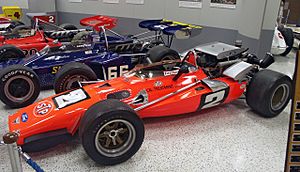
Mario was not happy being an owner-driver. He sold his team to Andy Granatelli's STP Corporation before the 1969 season. Granatelli kept the DVL cars and staff. Mario won nine races in 1969, including the 1969 Indianapolis 500 and the Pikes Peak International Hill Climb. He won his third title and was named ABC's Wide World of Sports Athlete of the Year. His prize money was the largest in American sports at that time.
Team Changes and Challenges (1970–1975)
The team broke up after the 1969 season. Mechanics Clint Brawner and Jim McGee left to start their own team. Mario stayed with STP. He finished fifth in 1970. In 1971, Mario dropped to ninth place in the USAC championship.
For the 1972 season, Mario left STP and joined Vel's Parnelli Jones Racing. This was a top IndyCar team. Mario persuaded them to hire Lotus designer Maurice Philippe. Jim McGee also joined the team. They hoped to be a "superteam."
Mario never won an IndyCar title with Parnelli. He finished 11th, 5th, and 14th in his three full seasons. But he did better on dirt tracks, winning the 1974 title.
During this time, Mario became more interested in formula racing. He raced in Formula One with Ferrari in 1972. He also raced in Formula 5000 in 1974 and 1975. In 1975, Mario stopped racing full-time in IndyCar. He focused on the Parnelli Formula One team.
Racing with Penske (1976–1978)
While racing with Team Lotus, Mario also raced sometimes in IndyCar with McGee's new team, Penske Racing. In 19 races from 1976 to 1978, he won one race and had eight top-five finishes.
Mario's Stock Car Racing Career
Mario also raced in top-level stock car racing from 1965 to 1969. He is one of only two drivers to win NASCAR's most famous race, the Daytona 500, without being a full-time stock car driver. The other is A. J. Foyt.
In NASCAR, Mario won one race, had one top-five finish, and three top tens in 14 races. He mostly drove for the Ford team Holman-Moody. He won the 1967 Daytona 500. Mario stopped racing in NASCAR after 1969.
In the 1970s and 1980s, Mario raced in the International Race of Champions (IROC). This was a special series for invited stock car drivers. He won IROC VI in 1979. He won three races in 20 events.
Mario's Formula One Career
Early Races (1968–1970)
The Indianapolis 500 was no longer part of the Formula One calendar after 1960. But some teams, like Colin Chapman's Team Lotus, still raced there. In 1965, Lotus star Jim Clark won the Indianapolis 500, and Mario finished third. Clark told Chapman about Mario. Chapman invited Mario to race in Formula One.
Mario joined Lotus for the 1968 Italian Grand Prix. He loved the Lotus 49B car. He broke the lap record at Monza in testing. But he was disqualified because he flew back to America for another race.
Mario's real start in Formula One was at the 1968 United States Grand Prix. He got the pole position, meaning he started first. He was the first Formula One driver to start his first race from pole. Jackie Stewart passed him on the first lap. But they raced closely until Mario's car had problems. He had to stop, but he had made a strong impression.
Chapman offered Mario a full-time job for 1969. But Mario said no because he wanted to keep his stable USAC career. For the next two years, he raced only sometimes in Formula One with Lotus and STP-March. The cars were not very good. He finished only one race in his first three seasons. At that race, the 1970 Spanish Grand Prix, he got his first Formula One podium finish.
Racing for Ferrari (1971–1972)
Mario signed with Scuderia Ferrari in 1971. He raced in seven of 11 races and finished two. In his first race for Ferrari, he won his first Grand Prix at Kyalami. The race leader's engine failed with four laps to go. He also won a non-championship race in California. After that win, Enzo Ferrari offered Mario to be his main driver for 1972. But Mario said no. He later said that Formula One "didn't pay much back then." Mario raced five times in 1972 but did not get any podiums. He did not race in the 1973 season.
Racing for Parnelli (1974–1976)
In the mid-1970s, Mario encouraged his IndyCar team, Parnelli, to have a Formula One car. They got money from Firestone for special tires. The team also hired more people from Lotus.
Parnelli raced Mario in two North American races in 1974. He started third at the United States Grand Prix but did not start the race due to a mechanical problem. Parnelli also raced Mario in the North American Formula 5000 series in 1974 and 1975. He finished second both times.
In 1975, Mario became a full-time Formula One driver. He was disappointed with the Parnelli VPJ4 car. Also, Firestone stopped sponsoring the team. The car was designed for Firestone's special tires, so its performance suffered without them. The car also had frequent brake problems. At the 1975 Spanish Grand Prix, Mario started fourth and reached first place after a crash. But the crash damaged his car, and he had to stop. He finished 14th in the Drivers' Championship with five points.
Parnelli skipped the first race of the 1976 season. Mario started the year with Lotus and then returned to Parnelli for two races. Parnelli left Formula One after the third race because their sponsor stopped funding them. Mario only found out when a reporter asked him about it. He later said that he was "the only one, really, that wanted [the Formula One team]."
Returning to Lotus (1976–1980)

The day after Parnelli closed, Mario met Colin Chapman of Lotus. Chapman told him he wished he had a good car for Mario. Mario took the Lotus job anyway. He promised Chapman they would make the car better. He made sure he was the number one driver. This meant he could use his teammate's car if it was faster.
The Lotus 77 car was not very good at first. With five races left, Mario had only five points. He asked to switch to next year's car, but Chapman said no. At the 1976 Dutch Grand Prix, Mario got his first podium since 1971. He got three podiums in the last five races. He won the last race of the season, the 1976 Japanese Grand Prix. These results moved Mario up to 6th place in the championship.
The Ground Effect Revolution
Mario rejoined Lotus just as "ground effect" technology was starting. Lotus was trying to make cars faster in corners without a big rear wing. They added sidepods that sucked the car to the ground. This allowed the car to take corners at very high speeds. Mario had experimented with sidepods before. He encouraged the team to make them even bigger.
Mario was very involved in developing the car. He knew Lotus had a reputation for dangerous designs. He worked with his mechanics to make sure Chapman didn't do anything "too radical." Mario noticed the car's downforce was stronger near a fence. Chapman then added "sideskirts" to keep the air flowing in one direction.
Mario was also good at setting up a car. He could feel tiny adjustments. He used his experience from oval racing to make his cars perfect for each track.
1977: Reliability Problems
In 1977, the Lotus 78 was one of the fastest cars. Mario won four races, more than any other driver. At Zolder, Mario got pole position by a huge margin.
Mario won the United States Grand Prix West. He also won the Spanish Grand Prix easily. He won the French Grand Prix after a dramatic last-lap pass. He also won his first Italian Grand Prix. Mario said the Lotus 78 was his favorite Formula One car.
But Mario had bad luck that season. The special engines Lotus used were not reliable. Mario's engine failed while he was leading in some races. He also ran out of fuel in three races. Ferrari won the Constructors' Championship. Mario finished third in the Drivers' Championship.
1978: World Champion
Mario won his first and only Formula One World Drivers' Championship in 1978. Before the season, the team signed Ronnie Peterson. Chapman promised Mario a bonus for each point he scored. Chapman also promised to use "team orders" to let Mario lead if Lotus was in first and second place.
The team used the Lotus 78 for the first five races. Mario won the first race, the Argentine Grand Prix. After five races, he was tied for second place.
Lotus then showed off the new Lotus 79 car. This car had an improved design for airflow. It had a lot of downforce, so Lotus could use a small rear wing. This made the car very fast. The 79 did have one problem: the brake fluid would overheat. Mario's smooth driving style suited the car. At Belgium, Mario got pole position by a lot. He led the whole race and won by ten seconds.
Mario dominated the rest of the season. He won five of the next eight races. His teammate Peterson finished second with two wins. Lotus had four races where they finished first and second. Mario won all of them. People wondered if Peterson was told to let Mario win. Both Mario and Peterson denied this.
Mario won the championship at the Italian Grand Prix, with two races left. But he did not celebrate. Peterson had a bad crash and passed away later that night. Mario said that he could "never truly celebrate" and never will. He called it an "enormous jolt."
After the Championship (1979–1980)
Mario never won another Grand Prix after 1978. Their main sponsor left after the 1978 season. In 1979, the team used the Lotus 80. This car had problems with its suspension. Mario got a podium in the Lotus 80's first race. But his new teammate, Carlos Reutemann, refused to drive the car. Mario drove it only three times before going back to the older Lotus 79. Mario finished 12th in the standings.
After the Lotus 80 failed, Chapman tried to fix the problem with the Lotus 88. This was a complex car made of carbon-fiber. The team used a temporary car, the Lotus 81, for 1980. Mario scored only one point all season. He lost faith in the Lotus 88. He left Lotus at the end of the season. The FIA later banned the Lotus 88.
Racing for Alfa Romeo (1981)
For the 1981 season, Mario signed with Alfa Romeo. He picked the Italian team because he was friends with one of their engineers and they offered more money. Before the season, a new rule banned sliding sideskirts. Alfa Romeo had relied on these for their car's design. Mario finished fourth in his first race. But the team was not very competitive. He finished 17th in the Drivers' Championship. He left the team after the season. He said the new Formula One cars were not as fun to drive.
Guest Appearances (1982)
In 1982, Mario briefly raced for two top teams: Williams and Ferrari. He joined Williams for one race. He had to stop after hitting a wall. He couldn't sign a full-time contract because of his IndyCar races.
Mario then replaced an injured driver at Ferrari for the last two races. He got pole position and finished third at the Italian Grand Prix. In his final Formula One race, the Caesars Palace Grand Prix, he had to stop due to a problem. But Ferrari won the Constructors' Championship. Mario agreed to be a reserve driver for one U.S. race in 1984. He officially ended his Formula One career.
Mario's CART IndyCar Career
Early CART Years (1979–1982)
In 1979, a new group called Championship Auto Racing Teams (CART) started the IndyCar World Series. This replaced the old USAC championship. CART was formed by bigger teams like Mario's Penske Racing. They wanted more technical innovation and a better business plan for the sport. Mario raced sometimes in CART in 1979 and 1980. He won one race in Michigan in 1980.
Mario switched to Patrick Racing for the 1981 season. This reunited him with his old sponsor, STP Corporation, and mechanic, Jim McGee. He did not win a race, but he had five top-five finishes. At the 1981 Indianapolis 500, Mario was controversially stripped of the win four months after the race. After leaving Formula One, Mario joined CART full-time for the 1982 season. He finished third in the standings with six podiums.
Newman/Haas Racing (1983–1994)
In 1983, Mario joined the new Newman/Haas Racing team. It was started by Carl Haas and actor Paul Newman. The team used cars built by a British company called Lola. Mario spent the rest of his full-time racing career with Newman/Haas.
Racing Solo
In 1983, Mario helped the team make the Lola T700 car better. He won the team's first race at Elkhart Lake. He also won in Las Vegas. He had eight top-five finishes.
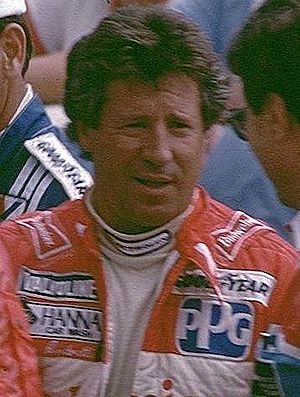
In 1984, the team used a new car, the Lola T800. This car was designed by Lotus veteran Nigel Bennett. It used the ground effect technology that Formula One had just banned. Mario won the first race of the season at Long Beach. But his Indianapolis 500 race had electrical problems. After four races, he was behind by 58 points. But in the middle of the season, he won five of eight races. This included the Michigan 500, where he won by a tiny margin. Mario won his fourth IndyCar title at age 44. He was voted Driver of the Year for the third time.
The team had a tougher year in 1985. Other teams started using Lola cars, which reduced Newman/Haas's advantage. Mario started fast, winning three of the first four races. He finished second at the 1985 Indianapolis 500. He had a 34-point lead. But he had only one more top-five finish and ended up fifth in the standings.
From 1986 to 1988, Mario's son Michael became a strong driver. In 1986, Michael finished second, beating Mario for the first time. Both father and son got five pole positions. Mario beat Michael by a very small margin at a race in Portland. At age 46, Mario finally won his home race, the Pocono 500, after 14 tries. He called it "one of the happiest weekends."
In 1987, Mario got eight pole positions but only two wins. He led most of the Indianapolis 500 but had an engine problem late in the race. At the next race, he passed A. J. Foyt for the all-time lead in laps led. But he crashed and hurt his neck.
In 1988, Mario finished fifth in the standings, one spot ahead of Michael. He won two races but had many mechanical problems and crashes.
Racing with Two Cars
Michael Andretti joined Newman/Haas in 1989. The team added a second car for him. Mario and Michael became the first father/son team to race together in both IMSA GT and IndyCar. Michael had a great career, winning the 1991 championship. Mario raced well but did not win any races from 1989 to 1992. In 1992, he set the record for most IndyCar starts.
Before the 1993 season, Michael Andretti left for Formula One. Mario wanted to go back to a one-car team. But the team replaced Michael with the Formula One champion, Nigel Mansell. Mansell became the main driver. Mansell and Andretti did not get along well. Mario won his last IndyCar race in 1993 at Phoenix. At 53 years old, he became the oldest winner in IndyCar history. Later that year, he set a new world record for speed on a closed course. He finished sixth in the standings, while Mansell won the title.
Mario decided to race one final season in 1994, called "The Arrivederci Tour." The team did not win any races that year. In his 407th and final IndyCar race, Mario's engine failed with four laps to go. When he retired, his 52 wins were the second-most in history. His 7,595 laps led are still the all-time record. His 67 pole positions were also an all-time record until 2022.
The Indianapolis 500
Mario won the Indianapolis 500 only once in 29 tries. He had three pole positions and started in the top three seven times. He finished all 500 miles only five times. He joked that if it had been the Indy 400, he would have won at least six times. He had so many problems and near-wins that some people talk about an "Andretti Curse."
Mario did have some good moments at Indianapolis. He won the 1969 race. He was lucky because he used the team's backup car and only one set of tires. His engineer said the car's gearbox was failing and would not have lasted five more laps. He was also the first driver to go over 200 miles per hour during practice in 1977.
Starting in 1981, Mario had many strange instances of bad luck at the Indianapolis 500. In 1981, he lost after another driver passed cars under a caution flag. In 1985, he finished second after Danny Sullivan spun without crashing. In 1987, he led most of the race but his engine failed. In 1992, he broke six toes, his son Jeff broke both legs, and his son Michael lost a big lead with 12 laps to go. In 1993, he led the most laps, but his team made a mistake with his tires during a pit stop. In 2003, at age 63, Mario tested an injured driver's car at Indianapolis. He had a "spectacular" airborne crash but had only minor injuries. Mario said in 2019 that he thinks about all the times he "should have won here." But he also won in 1969, "when everything went wrong."
Mario's Sportscar Racing Career
North American Endurance Racing
Mario's first sportscar race was in 1965. He raced a Ferrari 275 P but did not finish. Mario won three 12 Hours of Sebring races (1967, 1970, 1972). He also won a 6-hour race at Daytona in 1972. He often raced for Ferrari in sportscar events.
Mario signed with Ferrari in 1971. He won several races with co-driver Jacky Ickx. In 1972, he helped Ferrari win the World Championship for Makes. He also raced in 25 North American Can-Am races. His best finish was third place in 1969.
Racing at Le Mans
Mario raced at the 24 Hours of Le Mans in four different decades. In 1966, he raced a Ford Mk II but had to stop due to a valve problem. In 1967, during a pit stop, a mechanic put a brake pad in backward. Mario crashed, broke several ribs, and was in danger. But Roger McCluskey pulled him to safety.
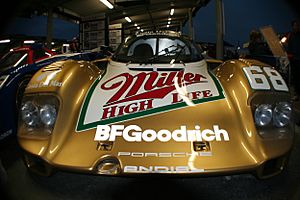
Mario did not return to Le Mans until after he stopped racing full-time in Formula One. In 1982, he raced with his son Michael. Their car was disqualified just before the race. They returned in 1983 and finished third in a Porsche car. The Andrettis returned in 1988 with Mario's nephew John. They finished fifth.
After Mario retired from full-time racing, he tried for another Le Mans win. He joined Courage Compétition from 1995 to 1997. In 1995, the team finished second overall and first in their class. Mario later said the team "lost [the 1995] race five times over" due to mistakes. In 1996, the team finished 16th after losing a lot of time fixing problems. In 1997, the car was old, and the team did not finish. Mario's last race at Le Mans was in 2000, six years after he retired. At 60 years old, he finished 15th.
Awards and Honors
Mario's Racing Legacy
| Competition | Wins |
|---|---|
| American Championship Car (IndyCar) | 52 |
| USAC Silver Crown Series | 5 |
| Formula One | 12 |
| F1 Non-Championship | 1 |
| Formula 5000 | 7 |
| Sports car | 7 |
| Stock car | 2 |
| IROC | 3 |
| USAC Sprint Car | 9 |
| Midget Car | 9 |
| 3/4 Midget Car | 4 |
Mario Andretti won over 100 races on major circuits during his long career. His exact number of wins depends on how a "major circuit" is defined. The International Motorsports Hall of Fame says he won 109 or 111 races. Mario and the Automotive Hall of Fame say 111.
Mario's name is now known for speed in American culture. He was a very versatile driver. He is unique, or almost unique, in winning in many different types of racing:
- He is the only driver to win the Indianapolis 500 (1969), Daytona 500 (1967), and the Formula One World Drivers' Championship (1978).
- He is one of only two drivers (with Dan Gurney) to win races in Formula One, IndyCar, the World Sportscar Championship, and NASCAR.
- He is one of only three drivers to win major races on road courses, paved ovals, and dirt tracks in one season. He did this four times.
With his last IndyCar win in April 1993, Mario became the first driver to win IndyCar races in four different decades. He was also the first to win car races of any kind in five decades. As of 2025, Mario's win at the 1978 Dutch Grand Prix is the most recent Formula One win by an American driver.
Awards and Recognition
Mario Andretti was named Driver of the Century by the Associated Press (1999) and RACER magazine (2000). In 1992, he was voted the U.S. Driver of the Quarter Century. He was named the U.S. Driver of the Year in 1967, 1978, and 1984. He is the only driver to be Driver of the Year in three different decades.
Mario has been inducted into many motorsports halls of fame. These include the International Motorsports Hall of Fame (2000), the Indianapolis Motor Speedway Hall of Fame (1986), and the Motorsports Hall of Fame of America (1990).
Several race tracks have named parts of their courses after Mario. These include "The Andretti" at the Circuit of the Americas and the "Andretti Hairpin" at Laguna Seca. Indianapolis renamed a street "Mario Andretti Drive" in 2019. Nazareth, Pennsylvania, where he lives, renamed his home street "Victory Lane" after he won the Indianapolis 500.
In 2003, a race at Road America was renamed the "Mario Andretti Grand Prix." This was because Mario helped keep it on the racing calendar.
In 2006, the Italian government made Mario a Commendatore of the Order of Merit of the Italian Republic. This is a high honor for his racing career and Italian heritage. In 2008, he was named honorary mayor of an association of Italian exiles from his birthplace. He also received the Carnegie Corporation's Great Immigrants Award (2006).
Mario's Personal Life
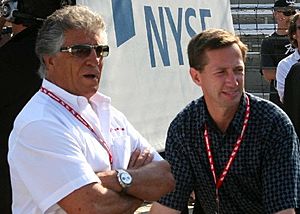
Mario Andretti lives in Bushkill Township, Pennsylvania, near Nazareth. His home is called "Villa Montona" after his birthplace. His late wife, Dee Ann, was from Nazareth. They met when she was teaching him English in 1961. They married on November 25, 1961. They had three children: Michael, Jeff, and Barbara. They also had seven grandchildren. Dee Ann passed away on July 2, 2018.
The Andretti Racing Family
Both of Mario Andretti's sons, Michael and Jeff, became race car drivers. Michael joined CART in 1983 and won the 1991 title. He was third on the all-time IndyCar wins list when he retired. Jeff Andretti raced in CART from 1990 to 1994. Mario's nephew John Andretti raced in CART and NASCAR. He won one CART race and two NASCAR races. In 2006, Mario's grandson Marco won the Indy Racing League Rookie of the Year award.
In 1991, the Andrettis became the first family to have four relatives race in the same series. The Andrettis have also raced together in endurance events. Mario, Michael, and John finished 6th at the 1988 24 Hours of Le Mans. Mario, Michael, and Jeff finished 5th at the 1991 Rolex 24 at Daytona.
Mario's Business Ventures
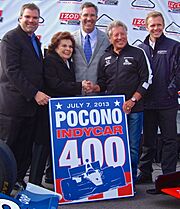
After retiring from full-time racing, Mario has stayed active in the racing world. He is on the board of the Cadillac Formula One team, which will join Formula One in 2026. Since 2012, Mario has been the official ambassador for the Circuit of the Americas (COTA) and the United States Grand Prix. He also tests cars for magazines and writes a racing column.
Mario's business interests go beyond racing. In 1995, he helped save a vineyard in Napa Valley and renamed it the Andretti Winery. In 1997, he started Andretti Petroleum, which owns gas stations and car washes. He also owns a chain of go-kart tracks. He was the main character in several video games, including Mario Andretti's Racing Challenge (1991).
Mario in Film and Television
Mario Andretti has been in several racing films. He is in and helps narrate The Speed Merchants (1972), a documentary about the 1972 World Sportscar Championship. He also drove an IndyCar in the IMAX film Super Speedway (1996). He appeared in the documentary Dust to Glory (2005). In November 2015, he was on the TV show Jay Leno's Garage. He drove fast cars with Jay Leno and talked about his career.
Mario has also made guest appearances in other media, usually related to racing. He was on the TV show Home Improvement. He had small roles in Bobby Deerfield (1977) and the animated films Cars (2006) and Turbo (2013). In Cars, he was a talking version of the car he won the 1967 Daytona 500 in. In Turbo, he voiced the traffic director at Indianapolis Motor Speedway.
Racing Record
Racing Career Summary
| Season | Series | Team | Races | Wins | Poles | F/Laps | Podiums | Points | Position |
|---|---|---|---|---|---|---|---|---|---|
| 1964 | USAC Championship Car | Dean Van Lines Racing Division | 8 | 0 | 0 | 0 | 1 | 530 | 11th |
| Lee S Glessner | 1 | 0 | 0 | 0 | 0 | ||||
| Doug Stearly | 1 | 0 | 0 | 0 | 0 | ||||
| 1965 | USAC Championship Car | Dean Van Lines Racing Division | 16 | 1 | 3 | ? | 10 | 3110 | 1st |
| 1966 | USAC Championship Car | Dean Van Lines Racing Division | 14 | 8 | 9 | ? | 9 | 3070 | 1st |
| Jim Robbins | 1 | 0 | 0 | 0 | 0 | ||||
| NASCAR Grand National Series | Owens Racing | 4 | 0 | 0 | 0 | 0 | N/A | NC | |
| 24 Hours of Le Mans | Holman & Moody | 1 | 0 | 0 | 0 | 0 | N/A | DNF | |
| 1967 | USAC Championship Car | Dean Van Lines Racing Division | 19 | 8 | 4 | ? | 13 | 3360 | 2nd |
| NASCAR Grand National Series | Holman & Moody | 6 | 1 | 0 | ? | 1 | N/A | 51st | |
| World Sportscar Championship | Ford Motor Co. | 2 | 1 | ? | 1 | 1 | N/A | NC | |
| 1968 | USAC Championship Car | Andretti Racing Enterprises | 27 | 4 | 8 | ? | 16 | 4319 | 2nd |
| NASCAR Grand National Series | Holman & Moody | 3 | 0 | 0 | ? | 0 | N/A | 51st | |
| Formula One | Gold Leaf Team Lotus | 1 | 0 | 1 | 0 | 0 | 0 | NC | |
| World Sportscar Championship | Autodelta SpA | 1 | 0 | 0 | 0 | 0 | 0 | 6th | |
| 1969 | USAC Championship Car | STP Corporation | 24 | 9 | 5 | ? | 13 | 5055 | 1st |
| Can-Am | Holman & Moody | 4 | 0 | 0 | 0 | 1 | 22 | 11th | |
| Formula One | Gold Leaf Team Lotus | 3 | 0 | 0 | 0 | 0 | NC | 0 | |
| NASCAR Grand National Series | Holman & Moody | 1 | 0 | 0 | 0 | 0 | NC | 0 | |
| 1970 | USAC Championship Car | STP Corporation | 18 | 1 | 4 | ? | 4 | 1890 | 5th |
| Formula One | STP Corporation | 5 | 0 | 0 | 0 | 1 | 4 | 15th | |
| Can-Am | SEFAC Ferrari | 1 | 0 | 0 | 0 | 0 | 8 | 23rd | |
| 1971 | USAC Championship Car | STP Corporation | 10 | 0 | 0 | ? | 1 | 1370 | 9th |
| Formula One | SEFAC Ferrari | 5 | 1 | 0 | 1 | 1 | 12 | 8th | |
| Can-Am | SEFAC Ferrari | 1 | 0 | 0 | 0 | 0 | 10 | 19th | |
| 1972 | USAC Championship Car | Vel's Parnelli Jones Racing | 10 | 0 | 1 | ? | 2 | 1135 | 11th |
| Formula One | SEFAC Ferrari | 5 | 0 | 0 | 0 | 0 | 4 | 12th | |
| 1973 | USAC Championship Car | Vel's Parnelli Jones Racing | 15 | 1 | 1 | ? | 3 | 2400 | 5th |
| 1974 | USAC Championship Car | Vel's Parnelli Jones Racing | 11 | 0 | 1 | ? | 1 | 655 | 15th |
| SCCA Continental Championship | 7 | 3 | 6 | 2 | 5 | 97 | 2nd | ||
| Formula One | 2 | 0 | 0 | 0 | 0 | 0 | NC | ||
| World Sportscar Championship | Autodelta | 1 | 0 | 0 | 0 | 0 | 0 | NC | |
| 1975 | Formula One | Vel's Parnelli Jones Racing | 12 | 0 | 0 | 1 | 0 | 5 | 14th |
| SCCA Continental Championship | 9 | 4 | 8 | 2 | 5 | 165 | 2nd | ||
| USAC Championship Car | 3 | 0 | 0 | 0 | 0 | 210 | 23rd | ||
| Sugaripe Prune Racing Team | 1 | 0 | 0 | 0 | 1 | ||||
| 1976 | Formula One | John Player Team Lotus | 13 | 1 | 1 | 1 | 3 | 22 | 6th |
| Vel's Parnelli Jones Racing | 2 | 0 | 0 | 0 | 0 | ||||
| USAC Championship Car | Penske Racing | 4 | 0 | 0 | ? | 1 | 1200 | 9th | |
| 1977 | Formula One | John Player Team Lotus | 17 | 4 | 7 | 4 | 5 | 47 | 3rd |
| USAC Championship Car | Penske Racing | 6 | 0 | 0 | ? | 1 | 1580 | 7th | |
| 1978 | Formula One | John Player Team Lotus | 16 | 6 | 8 | 3 | 7 | 64 | 1st |
| USAC Championship Car | Penske Racing | 8 | 1 | 0 | ? | 1 | 681 | 17th | |
| 1979 | Formula One | Martini Racing Team Lotus | 14 | 0 | 0 | 0 | 1 | 14 | 12th |
| BMW M1 Procar Championship | BMW Motorsport | 3 | 0 | 0 | 0 | 0 | 2 | 27th | |
| PPG Indy Car World Series | Penske Racing | 1 | 0 | 0 | ? | 1 | 700 | 11th | |
| 1980 | Formula One | Team Essex Lotus | 14 | 0 | 0 | 0 | 0 | 1 | 20th |
| PPG Indy Car World Series | Penske Racing | 4 | 1 | 2 | ? | 2 | 580 | 16th | |
| USAC Championship Car | Penske Racing | 2 | 0 | 0 | ? | 0 | 40 | 37th | |
| BMW M1 Procar Championship | BMW Motorsport | 1 | 0 | 0 | ? | 0 | 0 | NC | |
| 1981 | Formula One | Marlboro Team Alfa Romeo | 15 | 0 | 0 | 0 | 0 | 3 | 17th |
| PPG Indy Car World Series | Patrick Racing | 7 | 0 | 1 | ? | 4 | 81 | 11th | |
| 1981-82 | USAC Championship Car | Patrick Racing | 2 | 0 | 0 | ? | 1 | 805 | 6th |
| 1982 | PPG Indy Car World Series | Patrick Racing | 11 | 0 | 0 | ? | 6 | 188 | 3rd |
| Formula One | Ferrari | 2 | 0 | 1 | 0 | 1 | 4 | 19th | |
| TAG Williams Team | 1 | 0 | 0 | 0 | 0 | ||||
| 24 Hours of Le Mans | Grand Touring Cars Inc. | 1 | 0 | 0 | 0 | 0 | N/A | DNS | |
| 1982-83 | USAC Championship Car | Newman/Haas Racing | 1 | 0 | 0 | ? | 0 | 15 | 32nd |
| 1983 | PPG Indy Car World Series | Newman/Haas Racing | 13 | 2 | 2 | 2 | 6 | 133 | 3rd |
| 24 Hours of Le Mans | Porsche Kremer Racing | 1 | 0 | 0 | 0 | 1 | N/A | 3rd | |
| 1983-84 | USAC Championship Car | Newman/Haas Racing | 1 | 0 | 0 | ? | 0 | 20 | 20th |
| 1984 | PPG Indy Car World Series | Newman/Haas Racing | 16 | 6 | 8 | 6 | 8 | 176 | 1st |
| IMSA GT Championship | Porsche AG | 1 | 0 | 1 | 0 | 0 | N/A | NC | |
| 1985 | PPG Indy Car World Series | Newman/Haas Racing | 14 | 3 | 3 | 3 | 5 | 114 | 5th |
| 1986 | PPG Indy Car World Series | Newman/Haas Racing | 17 | 2 | 3 | 2 | 4 | 136 | 5th |
| 1987 | PPG Indy Car World Series | Newman/Haas Racing | 15 | 2 | 7 | 2 | 3 | 100 | 6th |
| 1988 | PPG Indy Car World Series | Newman/Haas Racing | 15 | 2 | 0 | 2 | 7 | 126 | 5th |
| 24 Hours of Le Mans | Porsche AG | 1 | 0 | 0 | 0 | 0 | N/A | 6th | |
| 1989 | PPG Indy Car World Series | Newman/Haas Racing | 15 | 0 | 0 | 0 | 4 | 110 | 6th |
| IMSA GT Championship | Busby Racing | 1 | 0 | 0 | 0 | 0 | N/A | NC | |
| 1990 | PPG Indy Car World Series | Newman/Haas Racing | 16 | 0 | 0 | 0 | 4 | 136 | 7th |
| 1991 | PPG Indy Car World Series | Newman/Haas Racing | 17 | 0 | 0 | 0 | 4 | 132 | 7th |
| IMSA GT Championship | Jochen Dauer Racing | 1 | 0 | 0 | 0 | 0 | 18 | 29th | |
| 1992 | PPG Indy Car World Series | Newman/Haas Racing | 15 | 0 | 1 | 0 | 1 | 105 | 6th |
| 1993 | PPG Indy Car World Series | Newman/Haas Racing | 16 | 1 | 1 | 1 | 3 | 117 | 6th |
| 1994 | PPG Indy Car World Series | Newman/Haas Racing | 16 | 0 | 0 | 0 | 1 | 45 | 14th |
| 1995 | 24 Hours of Le Mans | Courage Compétition | 1 | 0 | 0 | 0 | 1 | N/A | 2nd |
| 1996 | 24 Hours of Le Mans | Courage Compétition | 1 | 0 | 0 | 0 | 0 | N/A | 13th |
| 1997 | 24 Hours of Le Mans | Courage Compétition | 1 | 0 | 0 | 0 | 0 | N/A | DNF |
| 2000 | 24 Hours of Le Mans | Panoz Motorsports | 1 | 0 | 0 | 0 | 0 | N/A | 15th |
American Open-Wheel Racing Results
(key) (Races in bold indicate pole position)
USAC Championship Car
| USAC Championship Car results | |||||||||||||||||||||||||||||||||
|---|---|---|---|---|---|---|---|---|---|---|---|---|---|---|---|---|---|---|---|---|---|---|---|---|---|---|---|---|---|---|---|---|---|
| Year | Team | Chassis | Engine | 1 | 2 | 3 | 4 | 5 | 6 | 7 | 8 | 9 | 10 | 11 | 12 | 13 | 14 | 15 | 16 | 17 | 18 | 19 | 20 | 21 | 22 | 23 | 24 | 25 | 26 | 27 | 28 | Pos. | Pts |
| 1964 | Doug Stearly | Elder 61 FE | Offenhauser | PHX | TRE 11 |
INDY | MIL | 11th | 530 | ||||||||||||||||||||||||
| Lee S Glessner | Meskowski 58 D | LAN 9 |
|||||||||||||||||||||||||||||||
| Dean Van Lines Racing Division | Blum 64 FE | TRE 11 |
MIL 3 |
TRE 22 |
PHX 18 |
||||||||||||||||||||||||||||
| Kuzma 60 D | ISF 6 |
DSF 15 |
INF 10 |
SAC 8 |
|||||||||||||||||||||||||||||
| 1965 | Dean Van Lines Racing Division | Blum 64 FE | Offenhauser | PHX 6 |
TRE 2 |
ATL 2 |
LAN 4 |
1st | 3110 | ||||||||||||||||||||||||
| Hawk I | Ford 255 ci V8 | INDY 3 |
MIL 4 |
LAN 2 |
PPR | TRE Wth |
IRP 1 |
MIL 2 |
MIL 16 |
TRE 13 |
PHX 2 |
||||||||||||||||||||||
| Kuzma 60 D | Offenhauser | ISF 3 |
DSF 15 |
INF 2 |
SAC 3 |
||||||||||||||||||||||||||||
| 1966 | Dean Van Lines Racing Division | Hawk I | Ford 255 ci V8 | PHX 15 |
TRE 4 |
INDY 18 |
MIL 1 |
LAN 1 |
ATL 1 |
PPR | IRP 1 |
MIL 1 |
TRE 1 |
PHX 1 |
1st | 3070 | |||||||||||||||||
| Jim Robbins | Vollstedt 65 | LAN 21 |
|||||||||||||||||||||||||||||||
| Dean Van Lines Racing Division | Kuzma 60 D | Offenhauser | ISF 2 |
DSF 15 |
INF 1 |
SAC 10 |
|||||||||||||||||||||||||||
| 1967 | Dean Van Lines Racing Division | Hawk I | Ford 255 ci V8 | PHX DNS |
2nd | 3360 | |||||||||||||||||||||||||||
| Hawk II | TRE 1 |
INDY 30 |
MIL Wth |
LAN 3 |
IRP 1 |
LAN 1 |
MTR 1 |
MTR 1 |
MIL 1 |
TRE 25 |
HAN 24 |
PHX 1 |
RSD 3 |
||||||||||||||||||||
| Bobby Unser | Lotus 18/21 | Chevrolet V8 | PPR 14 |
||||||||||||||||||||||||||||||
| Dean Van Lines Racing Division | Hawk II | MOS 21 |
MOS 11 |
||||||||||||||||||||||||||||||
| Kuzma 60 D | Offenhauser | ISF 2 |
DSF 2 |
INF 1 |
SAC 2 |
||||||||||||||||||||||||||||
| 1968 | Andretti Racing Enterprises | Hawk II | Ford 255 ci V8 | HAN 23 |
LVS 2 |
PHX 15 |
TRE 2 |
PPR 4 |
MIL 2 |
2nd | 4319 | ||||||||||||||||||||||
| Hawk III | Ford 159ci V8 t | INDY 33 |
|||||||||||||||||||||||||||||||
| Ford 255 ci V8 | MIL 2 |
MOS 2 |
MOS 2 |
LAN 17 |
CDR 15 |
IRP 2 |
IRP 2 |
MTR 1 |
MTR 1 |
RSD 18 |
|||||||||||||||||||||||
| Kuzma 60 D | Offenhauser | NAZ 2 |
ISF 18 |
DSF 1 |
INF 2 |
SAC 4 |
|||||||||||||||||||||||||||
| Leader Card Racers | Watson 68 | Offy 159 ci t | LAN 23 |
LAN | |||||||||||||||||||||||||||||
| Andretti Racing Enterprises | Hawk II | TRE 1 |
MCH 2 |
HAN 3 |
PHX 24 |
||||||||||||||||||||||||||||
| 1969 | STP Corporation | Hawk III | Ford 159ci V8 t | PHX 16 |
HAN 1 |
INDY 1 |
MIL 7 |
TRE 1 |
MIL 4 |
DOV 11 |
TRE 1 |
PHX 21 |
1st | 5055 | |||||||||||||||||||
| Ford 255 ci V8 | LAN 5 |
CDR 10 |
IRP 9 |
IRP 2 |
BRN 4 |
BRN 3 |
SIR 1 |
SIR 2 |
RSD 1 |
||||||||||||||||||||||||
| Kingfish D | Chevrolet V8 | PPR 1 |
|||||||||||||||||||||||||||||||
| Kuzma 60 D | Offenhauser | NAZ 1 |
ISF 1 |
DSF 2 |
INF 6 |
SAC 15 |
|||||||||||||||||||||||||||
| 1970 | STP Corporation | Hawk III | Ford 159ci V8 t | PHX 13 |
TRE 2 |
colspan=2
See also
|
|||||||||||||||||||||||||||


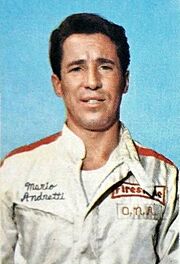


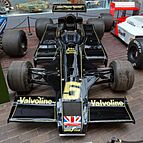
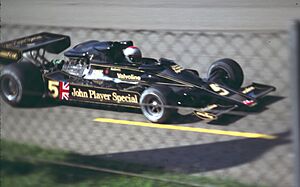
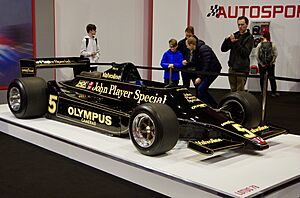

 In Spanish:
In Spanish: